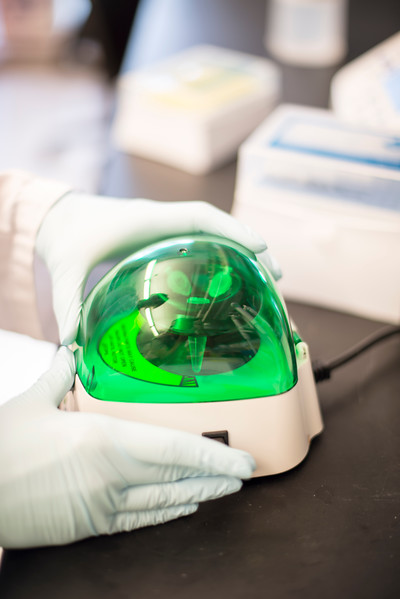Community care model improves uptake of TB preventive therapy, KZN study finds
The uptake and continuation of tuberculosis (TB) preventive therapy were much higher when it was provided through a community-based model compared to the standard clinic-based model, a study conducted in KwaZulu-Natal found. The findings were presented at the recent Conference for Retroviruses and Opportunistic Infections in Seattle, USA.
Among others, TB preventive therapy is recommended for people living with HIV in South Africa, a group that is at an increased risk of developing TB. The risk is higher when someone’s CD4 count is low – an indication that the immune system is compromised. The most common form of TB prevention therapy used in South Africa is an isoniazid pill taken for six or more months (commonly referred to as IPT or isoniazid preventive therapy). A shorter three-month regimen (called 3HP) consisting of the drugs rifapentine and isoniazid is being piloted in some districts.
But the uptake of TB preventive therapy in South Africa is suboptimal, says Dr Adrienne Shapiro, a co-author of the new study. She is an infectious disease specialist, epidemiologist, and assistant professor at the University of Washington. She lists several reasons for the suboptimal uptake, including TB prevention medication not being available at the clinics when patients come to initiate HIV treatment as well as complicated guidelines for initiation that change regularly. There is also the high turnover of staff and lack of clinician confidence in what the right process for initiation is or in whether TPT works, to begin with.
The uptake of TB preventive therapy in South Africa is suboptimal. – Dr Adrienne Shapiro
“Clinic visits, particularly for ART (antiretroviral therapy) initiation, they’re very busy. There’s a lot going on and the priority of TB preventive therapy is often not as high as the priority for doing other things, especially starting ART,” she says. Shapiro tells Spotlight their study “wanted to address these inefficiencies or these challenges for both patients and clinicians by simplifying the process and continuing to deliver TB preventive therapy with ART. But in a programme where the ART delivery process was greatly simplified and decentralised from the clinic”.
Study design
The new findings are from a sub-study nestled in a larger study called DOART. DOART looked at whether community-based ART initiation and delivery would improve HIV virologic suppression. In DOART, people living with HIV in a rural and a peri-urban region of KwaZulu-Natal province were randomised into one of three study arms for ART initiation and resupply of ART. One was the standard clinic-based ART with initiation and refills done at a public health sector clinic according to the clinic schedule. The second was a community arm where ART was initiated in the community via a mobile clinic van and refills provided. And finally, a hybrid arm where participants initiated ART at the clinic and then, after initiation, received their refills in the community through a mobile clinic van. The vans were staffed with nurses.
Enrolment was between February 2017 and February 2019, with a one-year follow-up.
Within the sub-study, IPT followed the ART distribution in each study arm, according to Shapiro. In the community and hybrid study arms, participants were initiated on ART and then seen one month later for a follow-up and then given the option of initiating IPT. After this, they were seen at quarterly follow-up visits where they got their ART and IPT refills. TB symptom screens and adherence assessments were done at each visit. The clinic arm followed the standard practices of a public health sector clinic.
Eligibility for participating in the DOART study was being clinically stable, not on ART, having a CD4 count of greater than 100, and screening negative for TB symptoms.
“For participants who did not initiate IPT at the month one visit, catch-up IPT could start at any subsequent visit,” Shapiro says. She explains that IPT initiation and continuation in the community and hybrid arms were measured with medication dispensing records and self-reported adherence given at the follow-up visits. In the clinic arm, initiation and continuation were measured by reviewing clinic charts, as participants did not have in-person follow-up by the study team until the end of the study.
A total of 1 039 participants initiated ART during DOART and then had the opportunity to initiate IPT. Of those, 55% initiated IPT at any point during the study. The study saw higher initiation of IPT in the rural region compared to the peri-urban region.
Large differences
The best results for starting IPT were seen in the community-based arm where 90% of those who started ART also started IPT. Within the clinic arm, 20% of participants started IPT and in the hybrid arm, 45% started IPT.
In terms of continuing IPT, in the clinic arm, 48% of those who started IPT continued to take it. In the hybrid arm, it was 84% and in the community arm, 89% of those who started IPT continued to take it.
“We found that initiation and continuation of TB preventive therapy were significantly higher with community-delivered HIV care than clinic-based treatment,” says Shapiro. “In the DOART study in South Africa, multi-month dispensing of IPT was safe and acceptable and use of point-of-care urine Isoniazid testing can enhance adherence monitoring,” she says. “We believe community-based integrated IPT delivery eliminated both provider and patient barriers to TPT by simplifying the process for both patients and providers.”
When asked whether there were concerns around initiating IPT outside of the clinic in the community arm, Shapiro says all participants did have one visit with a clinician and were screened for eligibility criteria and TB before the study. And those in the community arm were seen by a nurse during the quarterly follow-up visits in the mobile vans to get their ART and IPT refills. “Because there was still a nurse contact in the community arm that achieved the level of consistency with the kind of care someone would receive in a clinic,” Shapiro says.
Implications of results
Makaita Gombe, a Health Economist at the Aurum Institute who focuses on increasing efficiency in TB/HIV service delivery, explains that the study findings “show that community models of care are an important aspect of clinical care for people living with HIV.” The Aurum Institute is a research and health systems management organisation that focuses on TB and HIV prevention, treatment, and care.
She adds that it is feasible to potentially combine TPT and ART delivery services in community and clinic delivery settings to improve uptake and adherence to TPT. As this approach solves some of the socio-economic issues like a lack of resources to travel to healthcare facilities that users experience.
“Overburdened health systems also do not allow time for clinicians to dispense ART and counsel clients on TPT, therefore, TPT is seldom offered nor demanded by clients as they know very little about it,” she says. “We live in an age where clients have different lifestyles and clinical services need to evolve to suit the client’s needs. Innovations such as community initiations of TPT increase uptake because they meet the clients at their doorstep and allow them to stay healthy without disrupting their livelihoods.
“Advances in TPT options also allow patient-centred care with an expanded suite of TPT options available in South Africa as 3HP has been included in the national guidelines, further reducing TPT to three months, taken once a week,” Gombe adds.
Overburdened health systems also do not allow time for clinicians to dispense ART and counsel clients on TPT, therefore, TPT is seldom offered nor demanded by clients as they know very little about it. – Makaita Gombe, a Health Economist
Prospects for 3HP
Shapiro says that the next question they want to investigate is how 3HP can be provided together with ART. “We’re very interested in doing another round of studies looking at 3HP delivery, both in the community and in clinics to try to improve uptake. Also thinking about monitoring and adherence to make sure when people are getting medication, are they actually taking it and completing it in full,” she says.
She explains they tried to keep study conditions as true to the clinic setting as possible, so the IPT regimen given for six months was used because that’s what the public healthcare clinics they worked with in KZN were providing to patients.
[T]he next question they want to investigate is how 3HP can be provided together with ART.
The study was close to real-world conditions in other ways as well. No additional training was given to the study nurses, only refresher training in the community and hybrid arms about what IPT is, what doses to give, and what the possible side effects are. “All of the training was consistent with training that someone would have received in the public sector if training was operating on the intended schedule. We didn’t provide any information outside of what one would be expected to learn,” she says. “We didn’t want to interfere or impose anything in the public sector, so the clinic-based clinicians didn’t receive any additional training from the study in IPT or in monitoring delivery.”
Real-world challenges
The study did experience some challenges in the form of stockouts of the IPT medication at the public sector clinics that supplied medication to the study. It was also sometimes difficult to get hold of participants in the community and hybrid arms to set up their quarterly refill visits.
“I think that the main challenges encountered within the study were really mirroring those that are reflected in the public health sector on a regular basis,” Shapiro says.
As in the real world, treatment adherence was also not perfect. The researchers monitored adherence using a urine dipstick test in a subset of participants for the community and hybrid arms to see if they were actually taking the IPT.
[It] really created an opportunity for good adherence counselling, messaging, and some additional education that generally led to people deciding that they would take it in future.
A total of 255 participants who self-reported taking IPT were tested. Of those, 63% had a positive urine dipstick test that confirmed the presence of Isoniazid. Within the study, according to Shapiro, this discrepancy between self-reported adherence and a positive urine test allowed the nurses to have conversations with patients about whether they were actually taking their medication and address possible concerns.
“[It] really created an opportunity for good adherence counselling, messaging, and some additional education that generally led to people deciding that they would take it in future,” she says.
Feasible for the public sector?
Parts of the study that were novel at the time it was conducted were in the community-based and hybrid arms. Most notably, the mobile clinic vans that go to the community that delivered the services and the longer time frame in which IPT refills were given. Another novel approach was simplifying the delivery of ART and IPT by giving it all together.
“When the nurses were delivering a package of ART and IPT, it was all in one place. It was prepacked. It was all together. And that’s different from what would happen in the clinics where often people need to go to two different pharmacies to collect the ART and IPT,” Shapiro says.
Another novel approach was that study nurses in the community and hybrid arms had a mobile app prompting them to initiate IPT and screen for TB symptoms. However, Shapiro explains that this could easily be converted into paper-based prompts.
Overall, she says many aspects of the study are feasible to implement in a public sector clinic setting. “The study was really designed to not have too much by way of special new technology, but really it was a strategy of simplifying and spacing out delivery… and that could certainly be replicated in a programme in the public sector, either in a clinic or in a mobile delivery setting,” she says.
While the mobile van delivery system might not be available to all clinics, strategies from the study could easily be used, like simplifying IPT delivery for people living with HIV who are initiating ART. “When we look at the major difference in the IPT uptake, it’s really between that clinic-based arm and the community arm and so much of it in the clinic-based arm is that patients were just never given that first dose of IPT in the clinics,” she says.
The community delivery method aside, according to Shapiro, it’s important to figure out how to simplify TB preventive therapy initiation. Whether this is in the community or in the clinic. “If we can overcome that barrier, then we can really do quite a lot. I think that much of what we learned about the importance of simplifying delivery, making it very clear for clinicians that TB preventive therapy is just part of how you start, I think that can quite feasibly be integrated into public sector programmes,” Shapiro says.





